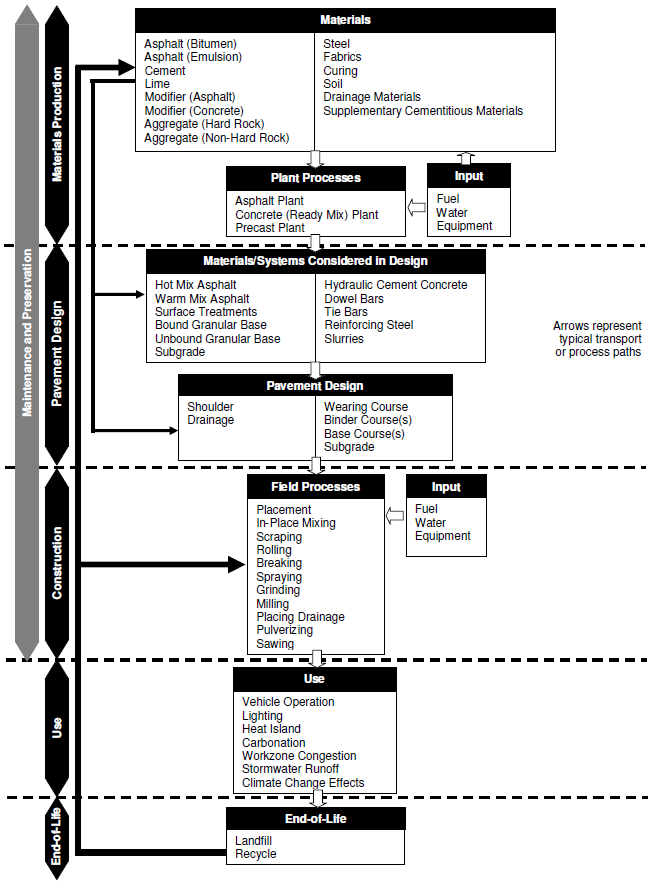The Pavement Life Cycle
The "pavement lifecycle" a categorical description of how a pavement interacts with surrounding systems throughout its life. While it is not the only way, it is a logical way to organize discussions of pavement sustainability. Figure 1 illustrates the various pavement lifecycle stages.

Figure 1. Pavement life-cycle phases (UCPRC 2010).
Materials Production
Pavement materials production refers to all processes involved in pavement materials acquisition (e.g., mining, crude oil extraction) and processing (e.g., refining, manufacturing, mixing). Plant processes (e.g., production of asphalt concrete[AC] by mixing aggregate, asphalt cement and additives; production of concrete by mixing aggregate, cementitious materials and additives) used in the materials production phase are typically included. Materials production affects such sustainability factors as air/water quality, ecosystem health, human health and safety, depletion of non-renewable resources, and life-cycle costs. See Chapter 3 (.pdf) of the Reference Document for more details.
Pavement Design
Pavement design refers to the process of identifying the structural and functional requirements of a pavement for given site conditions (subgrade, climate, existing pavement structure, traffic loadings) and then determining the pavement structural composition and accompanying materials. Included in this phase are the design processes for not only new pavement design, but also those processes associated with pavement rehabilitation (e.g., structural overlays, bonded/unbonded concrete overlays, crack-and-seat, rubblization). Structural design affects such sustainability factors as performance life, durability, life-cycle costs, construction (e.g., constructability, sequencing, schedule), and materials use. See Chapter 4 (.pdf) of the Reference Document for more details.
Construction
Pavement construction refers to all processes and equipment associated with the construction of pavement systems. Generally, construction activities are associated with initial construction as well as subsequent maintenance and rehabilitation efforts. Construction activities affect such sustainability factors as air and water quality, human health and safety, durability, and work zone traffic delay, as well as project costs and time. See Chapter 5 (.pdf) of the Reference Document for more details.
Use
Pavement use refers to interactions with vehicle operations and the environment. A number of key pavement factors (e.g., roughness, viscoelastic energy dissipation, deflection, macrotexture) can have large effects on most sustainability metrics, including fuel economy, vehicle operating costs, and associated greenhouse gas emissions and energy use. Environmental interactions (e.g., stormwater disposition, heat capacity/conductivity, and reflectivity) can also impact other sustainability factors such as human health and safety, the urban heat island effect, and radiative forcing on a global scale. See Chapter 6 (.pdf) of the Reference Document for more details.
Maintenance and Preservation
Pavement maintenance and preservation refer to actions that help slow the rate of deterioration of a pavement by identifying and addressing specific pavement deficiencies that contribute to overall deterioration. The following treatments are typically classified as maintenance and preservation activities: sealing, patching, seal coats, chip seals, thin overlays, in-place recycling of pavement surfaces, diamond grinding, load transfer restoration, and concrete pavement repairs. Maintenance and preservation impacts sustainability factors such as performance life, durability, life-cycle costs, construction (e.g., constructability, sequencing, schedule), and materials use. See Chapter 7 of the Reference Document for more details. See Chapter 7 (.pdf) of the Reference Document for more details.
End-of-Life
Pavement end-of-life refers to the final disposition and subsequent reuse, processing, or recycling of any portion of a pavement system that has reached the end of its useful life. Typical end-of-life considerations include: full-depth reclamation, recycled materials including reclaimed asphalt pavement (RAP) and recycled concrete aggregate (RCA), and landfilling. End-of-life considerations impact sustainability factors such as waste generation and disposition, air and water quality, and materials use. See Chapter 8 (.pdf) of the Reference Document for more details.
References
University of California Pavement Research Center (UCPRC). 2010. Pavement Life Cycle Assessment Workshop. UCPRC-TM-2010-03. University of California Pavement Research Center, Davis, CA. (Pavement Life Cycle Pavement Life Cycle Assessment Workshop (.pdf)).

